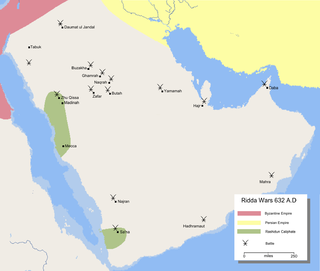Related Research Articles

Year 634 (DCXXXIV) was a common year starting on Saturday of the Julian calendar. The denomination 634 for this year has been used since the early medieval period, when the Anno Domini calendar era became the prevalent method in Europe for naming years.
The Battle of Buzakha took place between Khalid ibn al-Walid and Tulayha, in September 632.
The Battle of Ghamra took place between Khalid ibn al-Walid and the remaining army of Buzakha, 20 miles from Buzakha.
The Battle of Naqra took place in October 633 between rebel armies and Khalid ibn al-Walid's army during the Ridda Wars.
The Battle of Zafar took place in 632 between Khalid ibn al-Walid, a companion of the Islamic prophet Muhammad, and a tribal chieftess called Salma. Khalid defeated her and she died on the battlefield. The battle was part of the Ridda Wars.
The Battle of Hazir or Ma'arakah al-Haadhir took place between the Byzantine army and the Rashidun army's elite cavalry, the Mobile guard. It took place in June 637, three miles east of Qinnasrin at Al-Hadher in present-day Syria.

The Battle of Yamama was fought in December 632 as part of the Ridda Wars against a rebellion within the Rashidun Caliphate in the region of al-Yamama between the forces of Abu Bakr and Musaylima, a self-proclaimed prophet.
The Battle of the River, also known as Battle of Al Madhar, took place in Mesopotamia between the forces of the Rashidun Caliphate and the Sasanian Empire. Muslims, under Khalid ibn al-Walid's command, defeated the numerically superior Sasanian army.

The Battle of Ayn al-Tamr took place in modern-day Iraq (Mesopotamia) between the early Muslim Arab forces and the Sassanians along with their Arab Christian auxiliary forces. Ayn al-Tamr is located west of Anbar and was a frontier post which had been established to aid the Sassanids.

Battle of Muzayyah was between the Muslim Arab army and the Sasanian Empire. When Khalid ibn Walid left from Ayn al-Tamr to Dumat Al-Jandal for the help of Iyad ibn Ghanm, the Persian court believed that Khalid had returned to Arabia with a large part of his army. The Persians decided to throw the Muslims back into the desert and regain the territories and the prestige which the Persian Empire had lost. The Persians had resolved not to fight Khalid again, but they were quite prepared to fight the Muslims without Khalid ibn al-Walid.

Battle of Saniyy was between the Muslim Arab army and the Sasanian Empire. When Khalid ibn Walid gone from Ayn al-Tamr to Dumat Al-Jandal for the help of Iyad ibn Ghanm, The Persian court believed that Khalid had returned to Arabia with a large part of his army, Persians decided to throw the Muslims back into the desert and regain the territories and the prestige which the Empire had lost. The Persians had resolved not to fight Khalid again, but they were quite prepared to fight the Muslims without Khalid ibn al-Walid. Khalid ibn al-Walid first defeated them at the battle of Muzayyah and then advanced towards Saniyy.

The battle of Zumail was fought in 633 CE in Mesopotamia. It was a major Muslim victory in their conquest of that area. Under cover of night the Arab Muslims attacked the Christian-Arab forces, loyal to the Sasanian Empire, from three different sides. The Christian-Arab forces were unable to withstand the Muslim's surprise attack and soon dispersed but failed to escape from the battlefield and became the victims of a three sided attack by Khalid ibn al-Walid's army. At Zumail nearly the whole Christian Arab army was slaughtered by Khalid's Corps.

The Battle of Ullais was fought between the forces of the Rashidun Caliphate and the Sasanian Persian Empire in the middle of June 633 AD in Iraq, and is sometimes referred to as the Battle of Blood River since, as a result of the battle, there were enormous amounts of Persian Sasanian and Arab Christian casualties.

The Battle of Al-Anbar was between the Muslim Arab army under the command of Khalid ibn al-Walid and the Sasanian Empire. The battle took place at Anbar which is located approximately 80 miles from the ancient city of Babylon. Khalid besieged the Sassanian Persians in the city fortress, which had strong walls. Scores of Muslim archers were used in the siege. The Persian governor, Shirzad, eventually surrendered and was allowed to retire. The Battle of Al-Anbar is often remembered as the "Action of the Eye" since Muslim archers used in the battle were told to aim at the "eyes" of the Persian garrison.
The Battle of Marj Rahit was a minor conflict fought between the Ghassanid Arab allies of Byzantine Empire and the Rashidun army under the command of Khalid bin Walid in April 634. The morning after the Battle of Huwwarin, Khalid moved his army of 9000 towards Damascus.

The Battle of the Iron Bridge was fought between the Muslim Rashidun army and the Byzantine army in 637 AD. The battle took its name from a nearby nine-arch stone bridge spanning the Orontes River which had gates trimmed with iron. It was one of the last battles fought between the Byzantines and Rashidun Caliphate in the province of Syria. The aftermath of the battle marked the nearly complete annexation of the province into the Rashidun Caliphate with the fall of its capital, Antioch.
The siege of Germanicia or Marash was led by Muslim forces of the Rashidun Caliphate during their campaigns in Anatolia in 638. The city surrendered without much bloodshed. The expedition is considered significant due to the fact that it marked the end of the military career of the Arab Muslim general Khalid ibn Walid, who was dismissed from the army a few months after his return from the expedition.

Agha Ali Ibrahim Akram better known as A. I. Akram, was a Pakistani former three-star rank general, military strategist, historian, diplomat, and one of Pakistan's most influential military historians. In the 1980s, Akram was a well-known defence expert and defence analyst. His most popular work was his biography of Khalid ibn al-Walid, The Sword of Allah, which he published while serving in the Pakistan Army. For several years, it was compulsory reading in the Pakistan Army for admission into the Command and Staff College Quetta and has been on the leadership syllabus in the Malaysian Army. Akram was once seen as a close confidant and conceptual adviser of President Zia-ul-Haq.
The Battle of Marj ar-Rum, also known as the Battle of Marj Dimashq, was a conflict between the Rashidun caliphate and the Byzantine Empire. The battle occurred shortly after the Battle of Fahl when the Byzantines attempted to recapture Damascus. Heraclius, the Byzantine emperor, sent two separate forces in the effort, one army led by Theodore the Patricius and a second army led by Shannash al-Rome. The Rashidun army led by Abu Ubaydah ibn al Jarrah and Khalid ibn al-Walid was ordered to assist Yazid ibn Abi Sufyan who was acting as the garrison commander of Damascus.

The Battle of Abraq took place in the Abraq area, located about 8 kilometres (5.0 mi) north of Al Hinakiyah, in the Nejd region, in the central-western part of Saudi Arabia, in mid-August 632. It pitted the forces of the Rashidun Caliphate, led by Caliph Abu Bakr As-Siddiq, against rebellious Arab tribes led, according to Agha Ali Ibrahim Akram, by General Hibal ibn Khuwailid.
References
- A.I. Akram, The Sword of Allah: Khalid bin al-Waleed, His Life and Campaigns, Nat. Publishing. House, Rawalpindi (1970) ISBN 0-7101-0104-X.